Sitting in her stall outside a Catholic church in Shilin, Taipei, and equipped with a beauty kit, 61-year-old Mo Xiang-xiang (
Mo put white powder on her customer's face, then gently held one end of a thread in her teeth, the other in her hands, and moved the thread to trap rows of the customer's facial hairs and pull them out by the roots.
With more than 40 years of experience, Mo is a master of a traditional Asian technique for removing hair called wanmian (挽面), which literally means "threading the face."
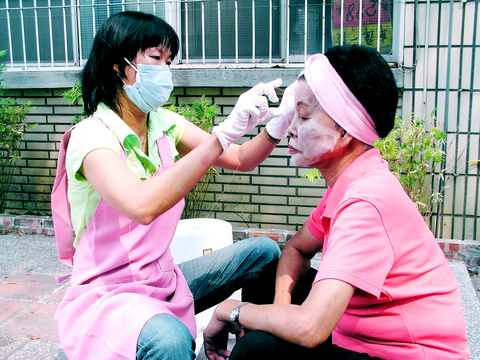
PHOTO: CHU YU-LING, TAIPEI TIMES
"Face-threading lights up your face by removing all unwanted facial hair. It's an old method, but it does more than lighting up your face. It brings you luck, too," she said.
Traditionally, face-threading was not only a beauty treatment but also a ritual for women the day before getting married. The ritual was called kaimian (
While many traditional practices have disappeared, face-threading has managed to survive, as some young ladies now embrace this traditional technique in their pursuit of natural beauty treatments.
On a sidewalk of Wenlin Road in Shilin, Mo and more than 10 other face-threading practitioners have lined up their stalls on "face-threading street," where this method has been practiced for more than 30 years.
Mo sets up her stall each day at about 8am, bringing along several chairs and her kit -- white powders, combs, hair clips and rolls of cotton thread -- and works until 5pm or 6pm in the evening regardless of customer flow.
Since more stalls have started popping up on "face-threading street," Mo said she usually had 5 to 6 customers during weekdays and more than 10 on weekends.
In addition to face-threading, which takes about 30 minutes and costs NT$200, Mo and other practitioners also provide other services, such as eyebrow threading and pedicures.
Compared to modern facial hair removal using tweezers, razors or even lasers, Mo said threading is more effective and natural, and hair regrowth becomes finer after regular treatments as the top layers of skin are not peeled or traumatized in the process.
"But of course threading could be painful for first-timers, but a little suffering for a beautiful face is definitely worth it," she said.
Sitting on a chair in Mo's stall facing the noisy street, 30-year-old Melody Chang (
"It hurt so much during my first face-threading that I burst into tears. But it doesn't hurt now, and my skin feels smooth and acne-free," she said.
The ancient method not only attracts young women like Chang, but also men and foreigners, practitioner Tina Wu (
"More and more men care about their appearance and are willing to give face-threading a try. Many foreign visitors who come to Shilin, especially Japanese, also try face-threading," she said.
Penny Tsai (
Wu said face-threading normally does not hurt the skin, but people with sensitive skin may feel uncomfortable. Unprofessional practitioners can also hurt a customer's skin, she said.
If the skin was still red or swollen after few days, customers should visit dermatologists and stop getting face-threading, Wu said.
Although doing face-threading does not make for an easy living, Wu, who learned the skill from her mother-in-law two years ago and now works at her stall every other day, said she is willing to pass on this traditional method so that it will not be lost.
"Face-threading is usually passed on as a family tradition and rarely taught to outsiders, so I feel privileged that my mother-in-law wanted to teach me the skill," she said.
Mo, who learned the skill from her grandmother, expressed the same concern that the technique would be lost.
In addition to her daughter, she has decided to pass on the tradition by offering courses to those who are interested.
"Many foreigners have told me that the face-threading technique in Taiwan is No.1 in the world," she said. "It's natural, it's cheap and it's effective. I can't let this tradition die with my generation."
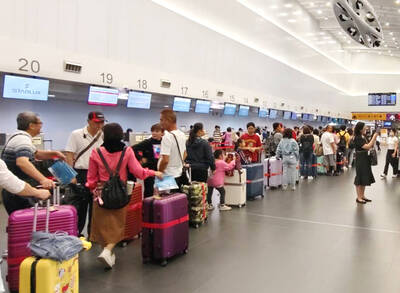
Three Taiwanese airlines have prohibited passengers from packing Bluetooth earbuds and their charger cases in checked luggage. EVA Air and Uni Air said that Bluetooth earbuds and charger cases are categorized as portable electronic devices, which should be switched off if they are placed in checked luggage based on international aviation safety regulations. They must not be in standby or sleep mode. However, as charging would continue when earbuds are placed in the charger cases, which would contravene international aviation regulations, their cases must be carried as hand luggage, they said. Tigerair Taiwan said that earbud charger cases are equipped
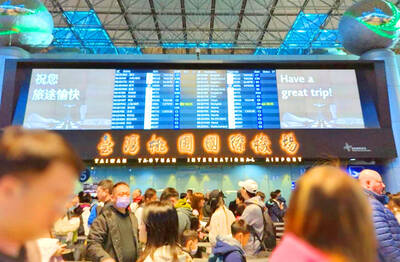
Foreign travelers entering Taiwan on a short layover via Taiwan Taoyuan International Airport are receiving NT$600 gift vouchers from yesterday, the Tourism Administration said, adding that it hopes the incentive would boost tourism consumption at the airport. The program, which allows travelers holding non-Taiwan passports who enter the country during a layover of up to 24 hours to claim a voucher, aims to promote attractions at the airport, the agency said in a statement on Friday. To participate, travelers must sign up on the campaign Web site, the agency said. They can then present their passport and boarding pass for their connecting international
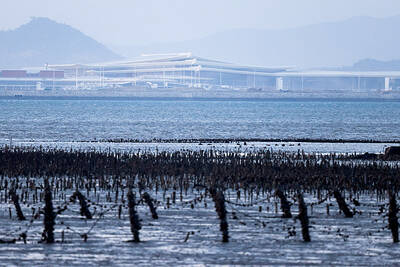
UNILATERAL MOVES: Officials have raised concerns that Beijing could try to exert economic control over Kinmen in a key development plan next year The Civil Aviation Administration (CAA) yesterday said that China has so far failed to provide any information about a new airport expected to open next year that is less than 10km from a Taiwanese airport, raising flight safety concerns. Xiamen Xiangan International Airport is only about 3km at its closest point from the islands in Kinmen County — the scene of on-off fighting during the Cold War — and construction work can be seen and heard clearly from the Taiwan side. In a written statement sent to Reuters, the CAA said that airports close to each other need detailed advanced
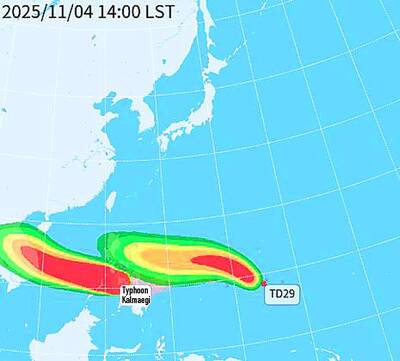
WEATHER Typhoon forming: CWA A tropical depression is expected to form into a typhoon as early as today, the Central Weather Administration (CWA) said yesterday, adding that the storm’s path remains uncertain. Before the weekend, it would move toward the Philippines, the agency said. Some time around Monday next week, it might reach a turning point, either veering north toward waters east of Taiwan or continuing westward across the Philippines, the CWA said. Meanwhile, the eye of Typhoon Kalmaegi was 1,310km south-southeast of Oluanpi (鵝鑾鼻), Taiwan’s southernmost point, as of 2am yesterday, it said. The storm is forecast to move through central